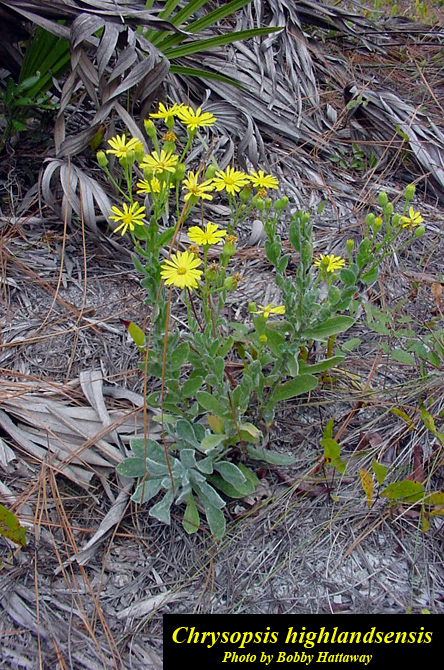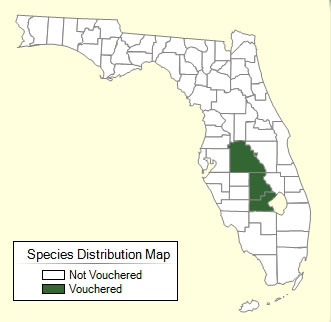Chrysopsis highlandsensis
| Chrysopsis highlandsensis | |
|---|---|

| |
| Photo by Bobby Hattaway, Atlas of Florida Vascular Plants | |
| Scientific classification | |
| Kingdom: | Plantae |
| Division: | Magnoliophyta - Flowering plants |
| Class: | Magnoliopsida – Dicotyledons |
| Order: | Asterales |
| Family: | Asteraceae ⁄ Compositae |
| Genus: | Chrysopsis |
| Species: | C. highlandsensis |
| Binomial name | |
| Chrysopsis highlandsensis DeLaney & Wunderlin | |

| |
| Natural range of Chrysopsis highlandsensis from Atlas of Florida Vascular Plants. | |
Common name: Highlands goldenaster
Contents
Taxonomic notes
Synonyms: none.[1]
Varieties: none.[1]
Description
C. highlandsensis is a perennial species with a short taproot and a basal rosette that shoots up a lanate flowering stem.[2]
Distribution
It is endemic to central peninsular Florida.[3]
Ecology
Habitat
C. highlandsensis is endemic to the Lake Wales Ridge and is found in sandpine scrubs, scrubby flatwoods, and turkey oak/longleaf communities.[2][4] It has been found in historically and chronically disturbed habitats like highway medians.[4] [5] It has also been observed to have a high survival rate after hurricanes.[6] Associated species include Lechea cernua, Polygonella basiramia, Selaginella arenicola, and Liatris tenuifolia.[4]
Phenology
It is a semelparous species, usually flowering the third year of life. Yellow composite flowers appear November and December.[2]
Seed dispersal
The fruit is a composite achene with a pappus modified for wind dispersal.[2]
Seed bank and germination
It has been found to divide by rhizomes, tubers, corms, and bulbs.[7] It has been observed to produce a limited persistent soil seed bank.[2]
Pollination
The following Hymenoptera families and species were observed visiting flowers of Chrysopsis highlandsensis at Archbold Biological Station:[8]
Andrenidae: Andrena fulvipennis
Apidae: Bombus impatiens
Halictidae: Agapostemon splendens, Lasioglossum miniatulus, Lasioglossum nymphalis
Megachilidae: Megachile brevis pseudobrevis, Megachile mendica
Conservation and management
Global Conservation Status: G2.[9]
Cultivation and restoration
Photo Gallery
References and notes
- ↑ 1.0 1.1 Weakley, A.S. 2015. Flora of the southern and mid-atlantic states. Working Draft of 21 May 2015. University of North Carolina at Chapel Hill, Chapel Hill, North Carolina.
- ↑ 2.0 2.1 2.2 2.3 2.4 [Archbold Biological Station]Accessed: December 4, 2015
- ↑ Weakley, Alan S. Flora of the Southern and Mid-Atlantic States: Working Draft of 21 May 2015. University of North Carolina Herbarium (NCU). PDF. 1102.
- ↑ 4.0 4.1 4.2 [University of Florida Herbarium]Accessed: December 4, 2015
- ↑ University of Florida Herbarium Database. URL: https://www.floridamuseum.ufl.edu/herbarium. Last accessed: May 2021. Collectors: Anne Cox and Heather Loring. States and counties: Florida: Polk.
- ↑ Menges, E. S., C. W. Weekley, et al. (2011). "Effects of Hurricanes on Rare Plant Demography in Fire-Controlled Ecosystems." Biotropica 43(4): 450-458.
- ↑ [Dave's Garden]Accessed: December 4, 2015
- ↑ Deyrup, M.A. 2015. Database of observations of Hymenoptera visitations to flowering plants on Archbold Biological Station, Florida, USA.
- ↑ [NatureServe]Accessed: December 4, 2015